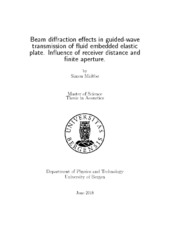| dc.description.abstract | For the past decades, plate transmission effects have been extensively studied with the incentive of applying the knowledge in GUW methods in the industry. With these studies, multiple anomalous effects have been identified, such as increase of on-axis pressure after transmission, downshift of frequency compared to plane-wave theory, and narrowing of transmitted beam. These effects are associated with leaky Lamb modes when the plate is immersed with a significant fluid loading. The studies on these effects have in general been performed with a point receiver, though in applications in the industry, the receiver is always of a finite order. An Angular Spectrum Method (ASM) model is developed for the study of plate transmission effects with a finite receiver. The model is based on a model by Anderson and Martin, who derived a plate transmission model using baffled pistons as source and receiver. They used the boundary condition that the normal particle velocity on the piston source surface is constant, and used this to derive an expression for the transmitted pressure on the surface of a finite receiver. Both of these models are compared with a third model derived by Orofino and Pedersen who developed a plate reflection model with baffled pistons as source and receiver, but with constant pressure on the piston source surface. They used this to derive an expression for the reflected normal particle velocity on the surface of a finite receiver. Their model is converted to a plate transmission case, as Waag did, and some comparisons with his work are also performed. Orofino and Pedersen/Waag excluded evanescent waves in the model, which may cause errors in the nearfield where the evanescent waves may be of an significant order. Therefore, the effect when excluding or including evanescent waves is investigated, along with the differences of boundary conditions. The developed model is used to study the influence of finite receiver in comparison with a point receiver, with a focus on the anomalous effects associated with leaky Lamb modes. Additionally, Waag stated that the frequency downshift is minimal when increasing the distance between the source and plate, and plate and receiver, when the distances are equal. There were not done any further inquisition to why. Therefore, the model developed is also used to investigate the effects and frequency downshift when the receiver is far from the plate, with and without finite receiver. | en_US |
